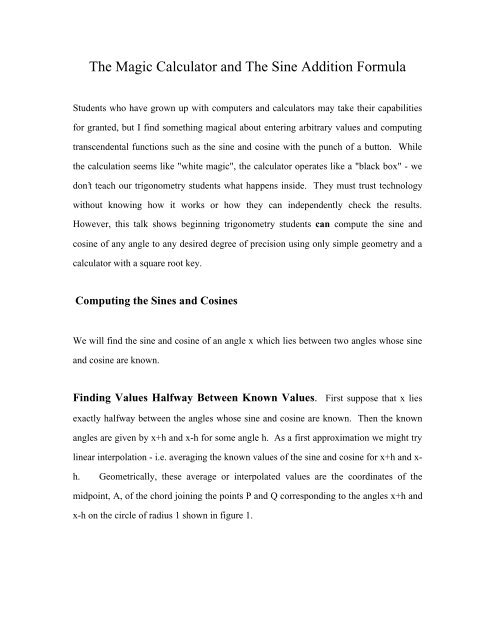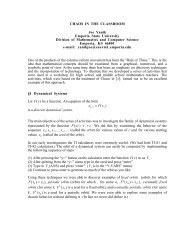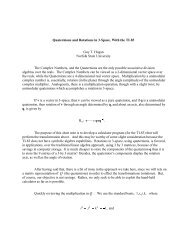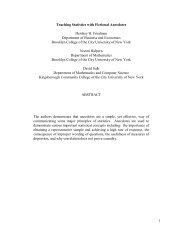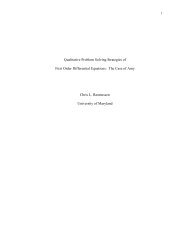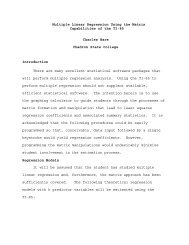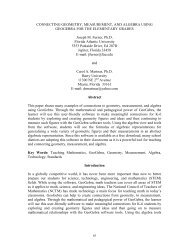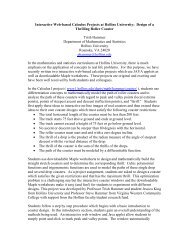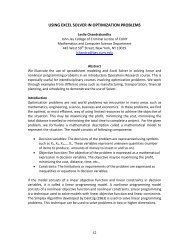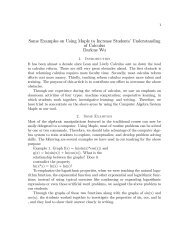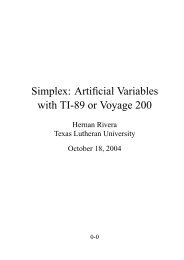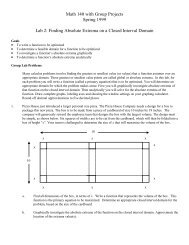The Magic Calculator and The Sine Addition Formula
The Magic Calculator and The Sine Addition Formula
The Magic Calculator and The Sine Addition Formula
Create successful ePaper yourself
Turn your PDF publications into a flip-book with our unique Google optimized e-Paper software.
<strong>The</strong> <strong>Magic</strong> <strong>Calculator</strong> <strong>and</strong> <strong>The</strong> <strong>Sine</strong> <strong>Addition</strong> <strong>Formula</strong>Students who have grown up with computers <strong>and</strong> calculators may take their capabilitiesfor granted, but I find something magical about entering arbitrary values <strong>and</strong> computingtranscendental functions such as the sine <strong>and</strong> cosine with the punch of a button. Whilethe calculation seems like "white magic", the calculator operates like a "black box" - wedon’t teach our trigonometry students what happens inside. <strong>The</strong>y must trust technologywithout knowing how it works or how they can independently check the results.However, this talk shows beginning trigonometry students can compute the sine <strong>and</strong>cosine of any angle to any desired degree of precision using only simple geometry <strong>and</strong> acalculator with a square root key.Computing the <strong>Sine</strong>s <strong>and</strong> CosinesWe will find the sine <strong>and</strong> cosine of an angle x which lies between two angles whose sine<strong>and</strong> cosine are known.Finding Values Halfway Between Known Values. First suppose that x liesexactly halfway between the angles whose sine <strong>and</strong> cosine are known. <strong>The</strong>n the knownangles are given by x+h <strong>and</strong> x-h for some angle h. As a first approximation we might trylinear interpolation - i.e. averaging the known values of the sine <strong>and</strong> cosine for x+h <strong>and</strong> x-h. Geometrically, these average or interpolated values are the coordinates of themidpoint, A, of the chord joining the points P <strong>and</strong> Q corresponding to the angles x+h <strong>and</strong>x-h on the circle of radius 1 shown in figure 1.
P=( cos(x+h), sin(x+h) )hAxB=( cos(x), sin(x) )Q=( cos(x-h), sin(x-h) )figure 1So, the coordinates of A can be easily computed <strong>and</strong> used as an approximation to those ofB, if A <strong>and</strong> B are not too far apart.But we can do even better. We can use the coordinates of A <strong>and</strong> similar triangles tocompute the coordinates of B exactly! (See figure 2.)P = ( cos(x+h), sin(x+h) )hAxB = ( cos(x), sin(x) )Q = ( cos(x-h), sin(x-h) )OC Dfigure 2Let A=(a 1 ,a 2 ) where a 1 <strong>and</strong> a 2 are found by averaging the known coordinates of P <strong>and</strong> Q.Recalling that the radius of the circle is one, we can use similar triangles OAC <strong>and</strong> OBDto compute sin(x):sin(x) = sin(x)1= sin(x)OB=a 2OA , (1)where OA=a 2 1 +a 2 2 can be computed using the Pythagorean theorem. Similarlya 1cos(x) =OA . (2)
Thus given the sine <strong>and</strong> cosine of any two angles, x+h <strong>and</strong> x-h, we can find the sine <strong>and</strong>cosine of the angle, x, halfway between them.Finding Arbitrary Values Between Known Values. To find the sine <strong>and</strong>cosine of an arbitrary angle, y, located between two angles, x+h <strong>and</strong> x-h, whose sines <strong>and</strong>cosines are known, students can write <strong>and</strong>/or use a TI-82 program, (see h<strong>and</strong>out: A TI-82Program to Compute <strong>Sine</strong>s from Scratch) that iterates the above procedure to "close in"on the desired angle. I have also had students use a spreadsheet to perform thecomputations one stage at a time. This method is similar to, <strong>and</strong> foreshadows, the"Midpoint Method" for finding the zeros of a continuous function that students mayencounter in a later course.Using the program, students find that the method “works” even if the known angles donot necessarily lie in the first quadrant <strong>and</strong> when sin(x) <strong>and</strong>/or cos(x) is negative.However, it gives unexpected results if the angle h is “too big”. Explaining these resultsis valuable preparation for the derivation that follows, as we shall see.Deriving sin(x+h) = sin(x) cos(h) + sin(h) cos(x)I was very pleased to find that the diagrams used above also yield a simple derivation ofthis important identity. Oddly enough (bad pun intended), the only additional fact used isthat sin(-x)=-sin(x).First note that the length OA computed in the above procedure is cos(h). One way to seecos(h)=OA is to think of line OB as the horizontal reference line of the circle. <strong>The</strong>n angleh is in st<strong>and</strong>ard position <strong>and</strong> OA clearly gives the "horizontal" coordinate of P.
1 2 (sin(x+h)+sin(x-h)) = a 2 = sin(x)cos(h) (7)Since the above formula holds for every value of x <strong>and</strong> h, we may interchange the valuesin x <strong>and</strong> h to get 1 2(sin(h+x)+sin(h-x)) = sin(h) cos(x), or12(sin(x+h)-sin(x-h)) = sin(h) cos(x) (8)Adding (7) <strong>and</strong> (8) yields the desired formula:sin(x+h)= sin(x) cos(h) + sin(h) cos(x). (9)Looking BackI believe the derivation given here rivals the method found in most texts ([1] [2] [3] [4][5] [6]) in logical simplicity. It’s not logically necessary to relate formulas (5) <strong>and</strong> (6) tothe computations of angles. <strong>The</strong>y are a simple consequence of the similar triangles infigures 2 <strong>and</strong> 3, however I believe it is pedagogically useful.Learning to compute sines <strong>and</strong> cosines of arbitrary angles provides motivation for thediagrams <strong>and</strong> students gain prior experience with the ideas ultimately used to obtain theformula. <strong>The</strong> student encounters <strong>and</strong> reconciles the difficult issues long before theidentity is mentioned, assimilating the ideas over an extended period, rather than facingthem all at once.Besides the pedagogic utility of computing sine values, I strongly believe in the intrinsicvalue of providing an alternative to the acceptance of calculator output entirely on faith. Ialso like the way technology is used as a thread linking the numeric, geometric, <strong>and</strong>symbolic aspects of a meaningful computation, <strong>and</strong> especially how technology is used toexplain how its own results might be obtained.References
1. Franklin Demana, Bert K. Waits, Stanley R. Clemens, with assistance of Alan Osborn<strong>and</strong> Gregory D. Foley, College Algebra & Trigonometry, A Graphing Approach, 2nd ed. ,Addison-Wesley, Oct. 1992, p. 410.2. Linda L. Exley, Vincent K. Smith, College Algebra <strong>and</strong> Trigonometry, Prentice Hall,Englewood Cliffs, New Jersey, 1993, p.630.3. Stanley I. Grossman, Algebra <strong>and</strong> Trigonometry, Saunders, 1989, p. 411.4. Ronald Harshbarger, James J. Reynolds, Algebra <strong>and</strong> Trigonometry, Brooks/Cole,Monterey California, 1987, p.289.5. Margaret Lial, Charles Miller, E. John Hornsby, Trigonometry, Harper Collins, 1993,p. 180.6. Michael Sullivan, College Algebra <strong>and</strong> Trigonometry, Dellen, San Francisco, 1987, p.514.


